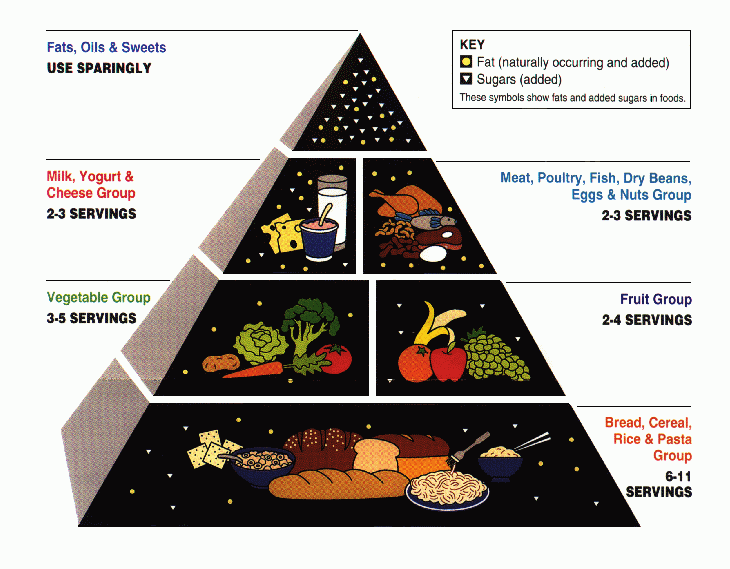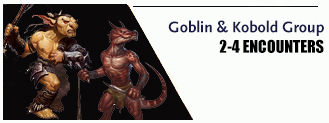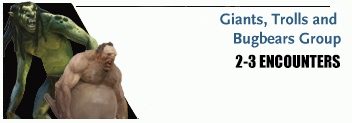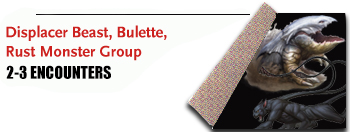There’s literally hundreds of published Dungeons & Dragons monsters out there – what’s the best way to keep track and categorize all them? An out-dated government nutrition guide? …well, probably not but we’re doing it anyway! Happy Thanksgiving!
As I was writing the previous “Let’s Use Our Libraries!” adventure, I accidentally stumbled onto an idea that I thought deserves a bit more exploring.
I had been commenting about how trolls were a “classic” monster archetype – and in my search of an adequate analogy, my 30-year-old Millenial self landed on the 1992 USDA Food Pyramid.
In case you aren’t a 90s kid, this image was an absolute staple in every elementary and middle school health textbook. It was a handy visual guide for the recommended portions of six-different food group. These days, nutritional sciences have advanced beyond geometric shapes to a far superior plate-based system. But the original Pharoah’s-tomb inspired approach has stuck in my head over the years.
And maybe because Thanksgiving and its related celebratory gluttony have been on my mind, this week I’ve kept wondering, “Could I fit D&D creatures into a Monster Pyramid?”
Well, yes, obviously the answer is yes. Otherwise I wouldn’t be writing this article.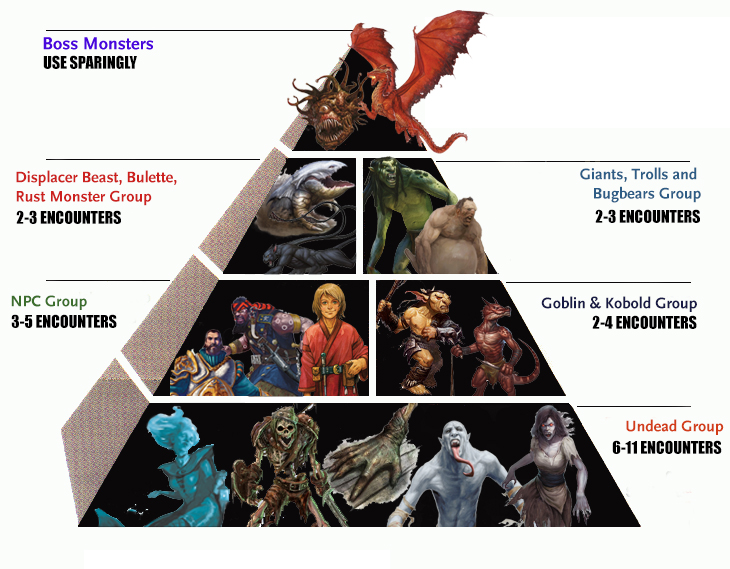
Now, the “recommended” serving size is a bit more tongue-in-cheek rather than a hard-fast guideline. But, I bet you could write a campaign that lasted 15-20 sessions that actually mirrored the original Food Pyramid ‘serving’ amounts.
But let’s go through each group of the pyramid and I’ll walk through my logic of where I placed each type of creature.
Undead Group
In the Food Pyramid, the largest section is reserved for breads and other grain food. As someone who has tried and given up on eating a keto diet – bread is in frickin’ everything. In Dungeons & Dragons encounter building that role is held by undead creatures.
Undead monsters are a stable and solid base for any D&D encounter. Without two slices of bread – a peanut butter and jelly sandwich is just a sad pile of gunk on your kitchen counter. Without a gang of zombies – a necromancer is just a creepy guy in black robes.
Undead creatures are versatile. There are dozens upon dozens of official stat blocks from the common zombie (Monster Manual, pg 316), to the party-killing Strength-draining shadow (MM, pg 269) to the tidal wave of bones of the skeletal juggernaut (Ghosts of Saltmarsh, pg 253).
They cover the entire range of CR and can be recurring threats throughout the entire life of your campaign. Pair a few undead minions with any of the other creatures from the other Monster Groups and you’ve got a great start to a sandwich.
Another benefit to including undead creatures in your encounter building is that they are evil by default. The ranger in your party who tries to make friends with every animal they come across – or your bard who just won’t. stop. rolling to seduce goblins- and well, it’s unlikely they’ll pull this sort of thing towards murderous skeletons. Movies and television love to pit anti-heroes against righteous villains – but personally, I don’t find “straightforward good vs. evil” to be boring.
Our next category is a bit more complicated.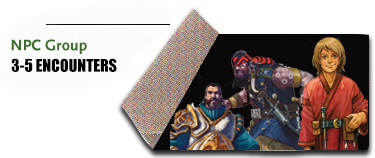
NPC Group
It’s hard to find somebody who is going to start rattling off vegetables as their favorite foods. But we all know their inclusion in the meal is critical. Especially if they’re prepared properly. NPCs could be groups of human bandits, a dwarven blacksmith hiring the party, or a fireball- hurling elven Fire Elemental evil cultist. A decent rule of thumb would say any character run by the DM from a player character race falls under the ‘NPC’ group. NPCs are civilized.
Their presence helps make the game world more authentic and relatable to the players in your campaign. It’s harder to understand the stakes of a campaign that features mimics (MM, pg 220) and imps (MM, pg 76) exclusively. The plight of a village of halfling beer brewers allows your players to interact with the inhabitants of the co-authored world of your campaign.
NPCs act with intelligence and agency. They are able to interact and influence all of the other creature groups. A single human knight (MM, pg 347) leading an army of commoners (MM, pg 345) raised from the countryside is a legitimate threat to an inexperienced young red dragon (MM, pg 98).
Of course, sometimes you still want to dip a veggie in some ranch.
NPCs have access to magic. Through the heretical devotion of a cult fanatic (MM, pg 345), or sheer mysticism of an archdruid (Volo’s Guide to Monsters, pg 210) – the majority of the mortal races in D&D have developed their own connections to the magical properties of D&D’s fantasy setting. Using this ability can be an expected twist for combat encounters involving NPCs. “Suddenly, the bandit on the cart raises her hands and the ground before your horse’s path erupts in vines!”
Unlike Undead, combat with NPCs is not necessarily to the death. Guards (MM, pg 347) may retreat from a losing fight to regroup and reinforce their ranks. An assassin (MM, pg 343) slips back into a crowded street after murdering a noble (MM, pg 348) ally of the party. The hobgoblin captain (MM, pg 186) would gladly accept the surrender of those equal to the party’s reputation.
But let’s take find middle ground between the extremes of NPC and Undead Monster Groups.
Goblin & Kobold
Fruits are vegetables’ cool cousin who lives in the two-towns over. He shows up like three times a year but always brought fireworks and a 6-pack of knock-off Corona. Kobolds, Goblins or even grung are more exotic and bizarre than NPCs. The “Goblin & Kobold” Group is a catch-all for any mostly-hostile alien-like creature in the creature encyclopedia. Goblins and kobolds are obviously their poster-children. But redcaps (Volo’s Guide to Monsters, pg 188) also fall into the category. Orcs straddle this Monster Group and the NPC bucket. I just invented a sliding scale to portraits of orcs in D&D. On one extreme are the mindlessly-loyal, animalistic soldiers of Sauron and on the other, the misunderstood spiritualists led to Kalimdor by Thrall. If your orcs fit in Mordor – you have “Goblins & Kobolds” orcs. If they should be yelling “LFG” in Orgrimmar, you are running your orcs as NPCs.
Like Undead, true Goblins & Kobolds are fairly guilt-free enemies for your party to cut down. It’s likely that goblins and the party will have pretty contradictory goals. Cheering for Team “Murder the farmers and steal their sheep!” or “Keep kidnapping religious pilgrims to feed to a dragon!” is tough. The more ‘human-like’ your portrayal of your myconid adults (MM, pg 232) – the closing you inch towards NPCs.
Embrace the weirdness of these creatures to make a Goblins & Kobolds encounter more memorable. Volo’s Guide to Monster has an entire section of unique kobold stat-blocks. The standout is the kobold inventor (VGM, pg 166) who counts a-skunk-tied-to-a-stick amongst its weapons.
Kobolds and other religious creatures may worship a being who can actively cause harm to civilized folk. Summoning “Drazyuth, Burner of Souls” may be the culmination of a particular goblin tribe’s belief structure – the folks over in Greenwald aren’t going to be as thrilled. Kobolds & Goblins certainly toe into the realm of the Boss Monster group. They may also have control over a member of the “Displacer Beast, Bulette, and Rust Monster” group. Or they may be controlled and used as thugs by a member of the “Giants, Trolls, and Bugbears” group.
Either way – the Goblins & Kobolds Group can be used as nice stepping stones to your party’s next tier of play. And you know I’m grabbing a handful of grapes and watermelon at the barbeque before I grab a burger at the end of the table.
Giants, Trolls, and Bugbears Group-
Flex your muscles – we’re at the protein food group. How do you think you’ll ever capitalize on your gains without eating 2 full chicken breasts every day? You need to be chugging some prime protein powder bro. No, the 10 lb bucket is the smallest amount they sell it in.
Protein is often the main element of the meal – and likewise, I see the Giants, Troll & Bugbears’s group fulfilling the need for a climax or a ‘wow’ moment after a series of more trivial encounters. In the most simple dungeon design, a PC party clears 2-3 rooms of goblins (MM, pg 166) and avoids one environmental trap or puzzle before arriving at the main chamber containing a ruling bugbear (MM, pg 33) chief.
I’d argue it’s even a disappointment if you exclude some sort of mini-boss in your encounter roadmap. I’d be making comparisons to an expensive three-course meal that served 3 trivially different plain salads.
These mini-bosses may use their influence with (and often over) the physically smaller Goblins & Kobolds Group to spread their own reach across the world. A hill giant (MM, pg 155) forces a kobold tribe to continually raid neighboring farms to steal chickens and crops to feed its colossal appetite. The influence may have been gained through more diplomatic means of course. Cross-group partnerships and mutual arrangements are frequent.
However, the range of this sphere of influence should be limited in scope and geography. Giants, Trolls & Bugbears are regional threats. Their ambition is limited to the immediate. They lack the patience to engineer any sort of long-term schemes. They are more blunt.
And in a strange way, their bluntness creates relatable stakes for your players. An ogre (MM, pg 237) has allied with a band of bullywugs (MM, pg 35) to force river barges to beach before devouring the crew. But the ogre isn’t you know – trying to crash the moon into the ocean to flood all the coastal cities. The tasty crew members are it’s only objective.
For even further diminished abilities to plan and set goals we look to the Displacer Beast, Bulette, & Rust Monster Group.
Displacer Beast, Bulette, & Ruster Monster Group.
I almost named the Displacer Beast, Bulette, & Ruster Monster Group the “Gygaxian Group”. As many of the D&D classic Gygax monsters fit squarely into this group – mimics (MM, pg 220), ropers (MM, pg 261), and owlbears (MM, pg 249) to name a few. But ‘fantastical animals’ not exclusive to D&D such as griffons (MM, pg 174) and basilisks (MM, pg 24) as well as the majority of elemental creatures are included in the group.
As a kid, I was told that the calcium held by the Milk, Yogurt & Cheese was the only preventing my legs from shattering when I got out of bed in the morning. In that vein, using this corresponding Monster Group can strengthen the bones of your campaign by rooting it firmly with the 45-year old history of the Dungeons & Dragon mythos. Adventurers have been being eaten by gelatinous cubes (MM, pg 242) since the 70’s. Honor the tradition of our forebearers and deal 3d6 acid damage to your college roommate’s paladin.
A quick glance through the previously listed monsters reveals they all have some sort of gimmick which makes them stand apart from the Giant & Troll Group. Mimics pretend to be chests, ropers appear to be stalactites when immobile, and owlbears…owlbears hoot and roar?
In a way – true Gygaxian Monsters are a bit meta; but in strange and specific ways. “A wolf-sized insect that eats metal?” asks the plate wearing fighter, “Okay Gary…” Often, they take the appearance of an object PCs could interact with while exploring an underground dungeon. Which, of course, was the game design of the original game.
But that’s part of their charm. The PCs don’t just have a sack of hit points to roll through – the creature’s uniqueness has added another complication to the combat. Another obstacle to overcome. Sometimes, you’re a party and you try the cheese platter because of the weird names or because someone points out their pungent aroma.
The goals of this group are perhaps the most instinctive of any. NPCs, Bosses, Giants, and even Goblins & Kobolds put more thought into their futures than most of the Displacer Beast, Bulette, and Rust Monster Group. And unlike Undead, they are rarely piloted by some higher intelligence. Most are only able to work towards simple creature comforts; enough food and personal safety.
In a DM’s toolbox, this Group makes excellent guardians for the ‘prize’ of your dungeon/string of related encounters. Whether that prize be rescuing a dwarven explorer from a nest of hungry owlbears or a magical short sword trapped and floating around a gelatinous cube- these creatures offer the heroic and triumphant moments in the party’s retelling of their victories. Whatever prize recovered from the clutches of this strange creature – it often moves the party closer to its confrontation with the Boss.
Boss Monsters
Don’t even pretend that you won’t grab a slice of Aunt Susie’s caramel apple pie even though you filled your place three times with turkey. But – you couldn’t just eat the entire tin of pie for Thanksgiving dinner and be particularly proud of your decisions.
The same can be said with ‘Boss Monsters’. These are dramatic opponents to face. They possess abilities that allow these monsters to break the very rules of the game. Lair Actions allow creatures to interrupt your players’ turns and Legendary Resistances encourages DMs to simply ignore a dice roll! This is the end of your campaign or at least – the end of a campaign chapter. Beholders (MM, pg 28) and ancient blue dragons (MM, pg 90) and of course the tarrasque (MM, pg 286) are major threats that only accomplished heroes should be able to defeat. And their defeat is a prize unto itself.
A party will need have needed to travel through some route of the other Monster Groups to collect various successes before even thinking about confronting this end game creature. Of course, this end game does not always need to hold the fate of the cosmos as its consequences.
Creatures in other groups are able to be promoted to the Boss Creature tier. If you add enough sugar and pie crust to an apple, it becomes a dessert. For example, a creative DM could take the stats of an orc war chief (MM, pg 246), increase its Hit Points, and grant it a few creative Legendary Actions – and it very easily becomes a sizeable threat on the duchy’s border.
The players may first need to rescue scouts captured by goblins; the scouts then report on the location of an orc raider encampment near Greenwald, as the party defeats the expedition force – the orcs release their phase spider (MM, pg 334) war beasts. The war chief hears of the failure of his raiders and seeks revenge – but the party has discovered the source of his unnatural power – a corrupted forgotten shrine.
Of course, the shrine is occupied by undead monstrosities of all sorts which must be vanquished. Unfortunately, this delays the party. Halfway through the ritual to sever the war chief’s connection to the Shadowfell – the war chief and his elite guard arrive at the shrine!
Weakened but still a dangerous foe; the orc uses its legendary actions to give its orc eye of Gruumsh (MM, pg 247) cultists free attacks and attack-of-opportunity immune extra re-positioning opportunities.
Once the war chief, the lands of the duchy sleep easier and the duke honors the PC with titles and land.
There! A little encounter chain ending with a mini-Boss that involves every other Monster Group. For a wider campaign-level or for higher-level PCs simply replace “kobold” with “githyanki”; the “orc war chief” for a mind flayer (MM, pg 222) and “duchy” with “world”. The basic structure is surprisingly portable.
So what do you think? A bit of a weird way to categorize D&D monsters – but I hope you find it as Thanksgiving-appropriate as I did.
What do you think about my categories? Would you have made changes? Or do you like the categories I highlighted, but think I misjudged certain creatures and placed them in the wrong bucket?
Let me know in the comments!
And remember, Frontline Gaming sells gaming products at a discount, every day in their webcart!
And check out the 2019 Black Friday specials!


